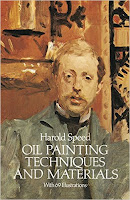 Welcome to the GJ Book Club. Today we'll cover pages 227-237 of the chapter on "Materials," from Harold Speed's 1924 art instruction book Oil Painting Techniques and Materials
Welcome to the GJ Book Club. Today we'll cover pages 227-237 of the chapter on "Materials," from Harold Speed's 1924 art instruction book Oil Painting Techniques and MaterialsI'll present Speed's main points in boldface type either verbatim or paraphrased, followed by my comments. If you want to add a comment, please use the numbered points to refer to the relevant section of the chapter.
In this section of the chapter, Speed discusses the pigments available to artists in his day.
| Portrait by Harold Speed |
I hadn't heard this before. Also, when he talks about permanency, I wonder if he means lightfastness or stability/cracking of the emulsion.
2. "The fewest colors possible should always be used."
This in contradiction to the usual advice to have a warm and cool red, warm and cool blue, plus earth colors, etc. Speed goes on to say: "The more brilliant colours have a fascination for the young students. Prone to messy handling and dirty brushes, they rush to the brighter pigments in the hope of getting themselves out of a mess; whereas with cleaner handling what is wanted could better be got by simple earth colours, the use of which gives one an excellent training in clean handling. The fine, dignified colouring of a Titian, or, among the moderns, a Watts, is greatly due to their extensive use of earth colours."
3. Flake (lead) white: more crisp, better body than zinc. Blackens when exposed to sulpheretted hydrogen" from gaslight.
Zinc White: shower at drying.
Speed describes titanium white as a "new white, said to be permanent, that has recently been discovered."
4. Earth colors are permanent with good body. He says: "Always do as much as you can with earth colors, especially early in the early stages of a picture."
I agree. Best to stay restrained in chroma and value in the underpainting, and save punch for final painting.
5. Ivory black
Safe, but slow drier. You can use an accelerator like copal to speed it up. Use for rich shadows. Good to have a blue-black to and to use warm and cool blacks.
6. Notes on specific pigments
Yellow ochre. Useful. Can mix with cadmium to brighten.
Terra vert. Olive green, good permanency, poor body. Good for modifying reds in flesh. Used by early painters for underpaintings.
Cadmium Yellows. He raises permanence issues, but I believe they have been settled in the pigments' favor according to modern manufacturing standards.
Emerald Oxide of Chromium. Speed recommends care because it's dangerous in the sense of being a strong acid color that can overpower a painting.
Madder reds. Again Speed cautions against intense red pigments in inexperienced hands, and he hadn't even seen the quinacridones and the naphthols invented after his day.
Alizarins. Modern substitutes are more permanent.
Rose doré. Good tinting strength.
Vermilion. He recognizes that the traditional pigment turns black (and is toxic).
Cobalt blue. "most useful blue on the palette."
French ultramarine. Best for dark shadows. Permanent. Not as opaque as cobalt.
Cyanine blue. Mixture of cobalt and Prussian.
Cobalt green. "beautiful opaque blue-green."
Cerulean blue. "opaque blue of lighter tone." Good in tints.
Lemon Yellow. "pale brilliant yellow of very light tone."
 Next week—We'll continue with brushes on page 237.
Next week—We'll continue with brushes on page 237.
-----
In its original edition, the book is called "The Science and Practice of Oil Painting ." Unfortunately it's not available in a free edition, but there's an inexpensive print edition that Dover publishes under a different title "Oil Painting Techniques and Materials
." Unfortunately it's not available in a free edition, but there's an inexpensive print edition that Dover publishes under a different title "Oil Painting Techniques and Materials (with a Sargent cover)," and there's also a Kindle edition.
(with a Sargent cover)," and there's also a Kindle edition.
----GurneyJourney YouTube channel
My Public Facebook page
GurneyJourney on Pinterest
JamesGurneyArt on Instagram
@GurneyJourney on Twitter







2 comments:
On point #1: If that's true I'm in a lot of trouble. But I'm not worried. I've painted that way for years and haven't noticed any change in permanence (re: either fading of flaking, etc.)
As for #6: Does he mention terra rosa? (I haven't been reading along.)I love it and find it very useful in many situations.
Did you ever find it odd that the cover illustration of Harold Speed's book on oil painting techniques and materials is a portrait of Charles Stuart Forbes painted by John Singer Sargent?
Wouldn't an example of Speed's own work, which is quite excellent, be more appropriate?
Post a Comment